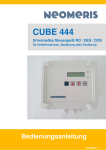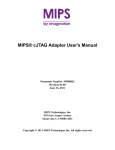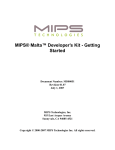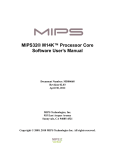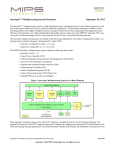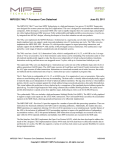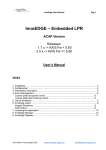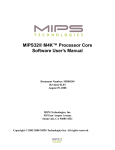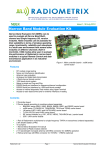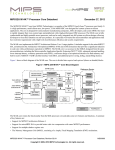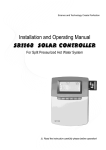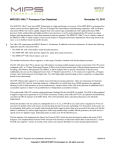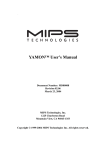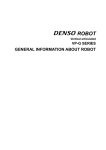Download Linux for the MIPS® Malta™ Development Platform User`s Guide
Transcript
Linux for the MIPS® Malta™ Development Platform User’s Guide Document Number: MD00646 Revision 01.03 October 30, 2008 MIPS Technologies, Inc. 955 East Arques Avenue Sunnyvale, CA 94085-4521 Copyright © 2008 MIPS Technologies Inc. All rights reserved. Contents Section 1: Introduction........................................................................................................................... 3 Section 2: Distribution Contents ........................................................................................................... 3 Section 3: Host System Requirements ................................................................................................. 3 Section 4: Installation............................................................................................................................. 3 Section 5: Booting Linux Kernel on Malta............................................................................................ 5 5.1: With Root File System on Hard Disk ........................................................................................................... 5 5.2: With Root File System Over ‘NFS’ .............................................................................................................. 6 5.3: Cloning the MALTA Root File System ......................................................................................................... 6 Section 6: Toolchains............................................................................................................................. 7 Section 7: Linux Kernel Known Issues................................................................................................. 8 Section 8: Support .................................................................................................................................. 8 Section 9: References ............................................................................................................................ 8 Section 10: Revision History ................................................................................................................. 9 2 Linux for the MIPS® Malta™ Development Platform User’s Guide, Revision 01.03 Copyright © 2008 MIPS Technologies Inc. All rights reserved. 1 Introduction 1 Introduction This document describes how to download, install, and boot the distribution of the Linux kernel and toolchain for the MIPS® Malta™ Development Platform. This version of the Linux operating system is customized to support the development of embedded applications for MIPS Technologies' 4KEc® and 4KSd™ CPU cores, and the 24K®, 24KE™, 34K® and 74K™ core families which support Release 2 of the MIPS32® Instruction Set Architecture (ISA). Release 1 processors are now supported, although so far only the 4Kc® processor has been tested. 2 Distribution Contents Linux distribution deliverables are available on MIPS Technologies' public website as a downloadable tar archive and on the hard disk supplied with the Malta board. The distribution includes the following: 1. Linux kernel, based on MIPS Technologies' stable 2.6.23 version, which contains support for all current MIPS cores, Instruction Set Architectures (ISAs), and Application Specific Extensions (ASEs). The complete source code for the kernel is included in order to simplify the reconfiguration and rebuilding of the kernel for the MALTA Development Platform if required. 2. Cross-development tools precompiled to run on the host machine and produce executables for use on the Malta. The tools are based on CodeSourcery G++ toolchain, which is derived from gcc-4.2, binutils-2.17.50, and includes support for all MIPS ISAs and ASEs. Both both big and little endian targets are supported. 3. A root filesystem (RFS) for the target board, consisting of precompiled development packages and utilities for the MIPS target architecture. 3 Host System Requirements The recommended host system configuration for installation is: • an Intel Pentium or compatible processor • 1 GByte RAM or more • 40 - 60 GBytes available disk space • A recent distribution of Linux. The libxml2 Python bindings, in the package python-libxml2, must be installed at the same time that Python is installed. 4 Installation This section describes the steps required to download and install the toolchain and kernel on your host machine. To begin, first create and then move to the directory that will contain the downloaded files. For example: Linux for the MIPS® Malta™ Development Platform User’s Guide, Revision 01.03 Copyright © 2008 MIPS Technologies Inc. All rights reserved. 3 4 Installation $ cd ~ ~$ mkdir CodeSourcery ~$ cd CodeSourcery Now set up an ftp connection to MIPS Technologies’ website: mipstech$ ftp ftp.mips.com and use “anonymous” in response to the name prompt from the ftp server: ftp> anonymous Use your email address as the password: ftp> <your.email.address> Move to the directory containing the files (the directory contents are invisible): ftp> cd outgoing Enable binary transfer mode: ftp> binary - Now you can choose between the little endian version: ftp> get mips-mipsisa32r2el-malta-fc5s-25-install.tgz or the big endian version of the toolchain: ftp> get mips-mipsisa32r2-malta-fc5s-29-install.tgz and then get the Linux kernel: ftp> get kernel_2.6.23.tar.bz2 ftp> bye Untar the toolchain tarball: mipstech$ tar xzvf mips-mipsisa32r2el-malta-fc5s-25-install.tgz Move to the toolchain directory: mipstech$ cd mips-mipsisa32r2el-malta-fc5s-25-install In supervisor mode, install the toolchain: mips-mipsisa32r2el-malta-fc5s-25-install$ sudo ./install Press <space bar> enough times and enter Y in the agreement. Now follow the directions until the components to be installed are displayed. Note: A known issue in the installation is that you must not "relocate" any of the components. The default location is /opt/timesys/toolchain... The toolchain will not function correctly if this location is changed. 4 Linux for the MIPS® Malta™ Development Platform User’s Guide, Revision 01.03 Copyright © 2008 MIPS Technologies Inc. All rights reserved. 5 Booting Linux Kernel on Malta Include the path to the toolchain: mips-mipsisa32r2el-malta-fc5s-25-install$ PATH=/opt/timesys/toolchain:$PATH mips-mipsisa32r2el-malta-fc5s-25-install$ cd .. Untar the kernel: mipstech$ tar xzvf kernel_2.6.23.tar.bz2 mipstech$ cd kernel_2.6.23 Config files are contained in the arch/mips/configs directory. Of particular interest are the files malta_aprpconfig, malta_smtcconfig, malta_smvpconfig, and malta_upconfig. For this example, malta_upconfig is used. Copy the appropriate config file: kernel_2.6.23$ cp arch/mips/configs/malta_upconfig .config You can modify configuration settings by opening menuconfig: kernel_2.6.23$ make menuconfig When finished making your modifications, exit and then build the kernel: kernel_2.6.23$ make CROSS_COMPILE=mipsisa32r2el-linux- When completed, the kernel file (vmlinux.srec) will be located in the directory arch/mips/boot. 5 Booting Linux Kernel on Malta The Linux kernel can be booted on the Malta board using the root file system on the Malta hard disk, using the root file system with NFS, or by cloning the Malta root file system. 5.1 With Root File System on Hard Disk Make the kernel available to tftp: kernel_2.6.23$ cp arch/mips/boot/vmlinux.srec /tftpboot/vmlinux_up_el.srec Check if the tftp-server and xinetd are installed: kernel_2.6.23$ rpm -q tftp-server kernel_2.6.23$ rpm -q xinetd If they are not installed, install and then enable them: kernel_2.6.23$ sudo /sbin/chkconfig tftp on # enable tftp server kernel_2.6.23$ sudo /etc/init.d/xinetd restart # make xinetd aware of tftp server Make sure the endian switch setting (S5) on the Malta is consistent with the endianess of the kernel to be used. Then restart the Malta board and enter the following command at the Yamon prompt: Linux for the MIPS® Malta™ Development Platform User’s Guide, Revision 01.03 Copyright © 2008 MIPS Technologies Inc. All rights reserved. 5 5 Booting Linux Kernel on Malta YAMON> load tftp://<hostIPaddress>/vmlinux_up_el.srec Transfer control to the kernel: YAMON> go . root=/dev/hda3 # /dev/hda3 is little endian file system In the above command, if the kernel was built using big endian, “root=/dev/hda3” is replaced by “root=/ dev/hda2”. After the kernel is loaded, a prompt is displayed. At this point, there is no password for the root account. 5.2 With Root File System Over ‘NFS’ First add the directory to be exported by opening the exports file: $ sudo <editor> /etc/exports and adding the following line: /opt/timesys/linux/6.2/mipsisa32r2el-std/rfs *(no_root_squash,anongid=0,rw,sync) The above command assumes the RFS is in /opt/timesys/linux/6.2/mipsisa32r2el-std/rfs. Export all directories in /etc/exports: $ sudo /usr/sbin/exportfs –a Restart NFS: $ sudo /etc/init.d/nfs restart Assign the correct values to the variables: YAMON> YAMON> YAMON> YAMON> set set set set bootserver 192.168.20.194 ipaddr <Malta board IP address> gateway <gateway IP address> subnetmask <subnet mask> Load the Linux kernel using the following commands: YAMON> set nfs1 “nfsroot=$bootserver:/opt/timesys/linux/6.2/” YAMON> set nfs2 “mipsisa32r2el-std/rfs,timeo=20 “ YAMON> set nfs3 “ip=$ipaddr:$bootserver:$gateway:$subnetmask” YAMON> go . $nfs1$nfs2 $nfs3 5.3 Cloning the MALTA Root File System All Malta boards include a disk that contains a root file system (RFS) with 16 versions of the Linux kernels 6 • little/big endian • uclibc/glibc Linux for the MIPS® Malta™ Development Platform User’s Guide, Revision 01.03 Copyright © 2008 MIPS Technologies Inc. All rights reserved. 6 Toolchains • aprp/smtc/smvp/up To boot any of the available kernels, use the following Yamon commands: YAMON> disk read hda 3f ff 800d0000 YAMON> go 800d0000 During the boot process, you will choose which kernel to boot and which partitions to be mounted. To clone the root file system, first create on the host a gzipped tar file of the root file system. $ cd /opt/timesys/linux/6.2/mipsisa32r2el-std/rfs rfs$ sudo tar cvzf rfs.tar.gzip Now on the Malta, login as root (no password at this time) and using the IP addresses used in the previous examples, mount the drive, move to that directory, and then do a secure copy of the gzipped tar file containing the root file system that we generated on the host to the current directory (/mnt). # mount /dev/hda8 /mnt # cd /mnt mnt # scp 192.168.20.194:/opt/timesys/linux/6.2/mipsisa32r2el-std/rfs/rfs.tar.gzip . mnt # tar xvzf rfs. tar.gzip The last step untars the root file system on /mnt, effectively putting the new file system onto the /dev/hda8 partition, The above example assumes that the RFS was installed in: /opt/timesys/linux/6.2/mipsisa32r2el-std/ rfs. Note: You should never overwrite the partition from which the system was booted. 6 Toolchains The host cross-toolchains are prefixed by the target names. For little endian, this is "mipsisa32r2el-linux", for example, “mipsisa32r2el-linux-gcc”. This name reflects the fact that both the native/target and cross/host compilers are configured to generate code which is, by default, compatible with either Release 1 or Release 2 of the MIPS32 ISA (i.e. -march=mips32r1 or -march=mips32r2). You can instruct the compiler to generate code for other ISAs and cores. By default the code generated by the compiler is optimized for the 4Kc/24K/34K pipeline. Normally this will provide excellent performance on all MIPS32 Release 1 or 2 cores; however, if you know that your code will run only on a specific CPU core, you may obtain more optimal code by specifying an explicit CPU type, for example, -march=24k, -march=34k, -march=4kec, -march=4ksd or -march=74kc. Note that this may enable the use of instructions which are not available, or are sub-optimal, on other cores. To enable the builtin compiler intrinsics for the DSP ASE, available on the 24KE and 34K families, you must specify one of -mdsp, -march=24ke, or -march=34k. To enable use of the SmartMIPS ASE, a feature of the 4KSd core, specify either -msmartmips or -march=4ksd. Linux for the MIPS® Malta™ Development Platform User’s Guide, Revision 01.03 Copyright © 2008 MIPS Technologies Inc. All rights reserved. 7 7 Linux Kernel Known Issues Use of the multi-threading ASE is automatic when a program uses pthread_create() etc, so long as you are running the SMTC or SMVP versions of the kernel on an MT-capable core. Both VPEs will be used to execute threads within your program in parallel. No extra action is required by the programmer. The non-standard -mallow-branch-to-undefined option may be used when building certain boot loaders which need this feature. It is not possible to build and run applications on Linux that have been compiled using the MIPS16 ASE. 7 Linux Kernel Known Issues No known issues. 8 Support MIPS Technologies provides support for the Linux distribution through the following channels: • WWW documentation pages at http://www.mips.com. This should be your first call when looking for the answer to any problems or queries you may have. There may be updated versions of the documents available on the site. • Support for the Timesys release can be purchased from Timesys. • Issues specific to the Malta Development Platform can be sent to [email protected]. 9 References 8 1. MIPS Malta™ User’s Manual MIPS Document: MD00048 2. Malta™ Developer's Kit Getting Started MIPS Document: MD00051 3. Yamon™ Users Manual MIPS Document MD00008 Linux for the MIPS® Malta™ Development Platform User’s Guide, Revision 01.03 Copyright © 2008 MIPS Technologies Inc. All rights reserved. 10 Revision History 10 Revision History Revision Date Description 01.00 October 30, 2008 Initial version. 01.01 XXX Input from Chris R & Jaidev 01.02 XXX Input from Hieu, Chrisr & Terrence 01.03 October 30, 2008 Input from Terrence & Chris D Linux for the MIPS® Malta™ Development Platform User’s Guide, Revision 01.03 Copyright © 2008 MIPS Technologies Inc. All rights reserved. 9 Unpublished rights (if any) reserved under the copyright laws of the United States of America and other countries. This document contains information that is proprietary to MIPS Technologies, Inc. ("MIPS Technologies") one of the Imagination Technologies Group plc companies. Any copying, reproducing, modifying or use of this information (in whole or in part) that is not expressly permitted in writing by MIPS Technologies or an authorized third party is strictly prohibited. At a minimum, this information is protected under unfair competition and copyright laws. Violations thereof may result in criminal penalties and fines. Any document provided in source format (i.e., in a modifiable form such as in FrameMaker or Microsoft Word format) is subject to use and distribution restrictions that are independent of and supplemental to any and all confidentiality restrictions. UNDER NO CIRCUMSTANCES MAY A DOCUMENT PROVIDED IN SOURCE FORMAT BE DISTRIBUTED TO A THIRD PARTY IN SOURCE FORMAT WITHOUT THE EXPRESS WRITTEN PERMISSION OF MIPS TECHNOLOGIES, INC. MIPS Technologies reserves the right to change the information contained in this document to improve function, design or otherwise. MIPS Technologies does not assume any liability arising out of the application or use of this information, or of any error or omission in such information. Any warranties, whether express, statutory, implied or otherwise, including but not limited to the implied warranties of merchantability or fitness for a particular purpose, are excluded. Except as expressly provided in any written license agreement from MIPS Technologies or an authorized third party, the furnishing of this document does not give recipient any license to any intellectual property rights, including any patent rights, that cover the information in this document. The information contained in this document shall not be exported, re-exported, transferred, or released, directly or indirectly, in violation of the law of any country or international law, regulation, treaty, Executive Order, statute, amendments or supplements thereto. Should a conflict arise regarding the export, reexport, transfer, or release of the information contained in this document, the laws of the United States of America shall be the governing law. The information contained in this document constitutes one or more of the following: commercial computer software, commercial computer software documentation, or other commercial items. If the user of this information, or any related documentation of any kind, including related technical data or manuals, is an agency, department, or other entity of the United States government ("Government"), the use, duplication, reproduction, release, modification, disclosure, or transfer of this information, or any related documentation of any kind, is restricted in accordance with Federal Acquisition Regulation 12.212 for civilian agencies and Defense Federal Acquisition Regulation Supplement 227.7202 for military agencies. The use of this information by the Government is further restricted in accordance with the terms of the license agreement(s) and/or applicable contract terms and conditions covering this information from MIPS Technologies or an authorized third party. MIPS, MIPS I, MIPS II, MIPS III, MIPS IV, MIPS V, MIPSr3, MIPS32, MIPS64, microMIPS32, microMIPS64, MIPS-3D, MIPS16, MIPS16e, MIPS-Based, MIPSsim, MIPSpro, MIPS-VERIFIED, Aptiv logo, microAptiv logo, interAptiv logo, microMIPS logo, MIPS Technologies logo, MIPS-VERIFIED logo, proAptiv logo, 4K, 4Kc, 4Km, 4Kp, 4KE, 4KEc, 4KEm, 4KEp, 4KS, 4KSc, 4KSd, M4K, M14K, 5K, 5Kc, 5Kf, 24K, 24Kc, 24Kf, 24KE, 24KEc, 24KEf, 34K, 34Kc, 34Kf, 74K, 74Kc, 74Kf, 1004K, 1004Kc, 1004Kf, 1074K, 1074Kc, 1074Kf, R3000, R4000, R5000, Aptiv, ASMACRO, Atlas, "At the core of the user experience.", BusBridge, Bus Navigator, CLAM, CorExtend, CoreFPGA, CoreLV, EC, FPGA View, FS2, FS2 FIRST SILICON SOLUTIONS logo, FS2 NAVIGATOR, HyperDebug, HyperJTAG, IASim, iFlowtrace, interAptiv, JALGO, Logic Navigator, Malta, MDMX, MED, MGB, microAptiv, microMIPS, Navigator, OCI, PDtrace, the Pipeline, proAptiv, Pro Series, SEAD-3, SmartMIPS, SOC-it, and YAMON are trademarks or registered trademarks of MIPS Technologies, Inc. in the United States and other countries. All other trademarks referred to herein are the property of their respective owners. Template: nW1.03, Built with tags: 2B Linux for the MIPS® Malta™ Development Platform User’s Guide, Revision: 01.03 Copyright © 2008 MIPS Technologies Inc. All rights reserved.










